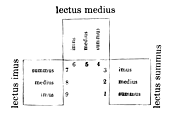Triclinium
(
τρίκλινον). The dining-room of a Roman house, as to the
position of which, relatively to the other parts of the house, see
Domus, pp. 547, 549, with the diagrams there given. It was of an oblong
shape, and was twice as long as it was broad. The superintendence of the diningroom in a great
house was intrusted to a slave called
tricliniarcha, who, through other
slaves, took care that everything was kept and proceeded in proper order. A triclinium
generally contained three couches, and as the usual number of persons occupying each couch was
three, the triclinium afforded accommodation for a party of nine. Sometimes, however, as many
as four lay on each of the couches. Each man, in order to feed himself, lay flat upon his
breast, or nearly so, and stretched out his hand towards the table; but afterwards, when his
hunger was satisfied, he turned upon his left side, leaning on his elbow.
To this Horace alludes in describing a sated person turning in order to repose upon his elbow
(
Sat. ii. 4, 39; but see Palmer
ad loc.). We find
the relative positions of two persons who lay next to one another commonly expressed in the
prepositions
super or
supra and
infra. A passage of Livy (xxxix. 43), in which he relates the cruel conduct of the
consul L. Quintius Flamininus, shows that
infra aliquem cubare was the
same as
in sinu alicuius cubare, and consequently that each person was
considered as
below him to whose breast his own head approached. On
this principle we are enabled to explain the denominations both of the three couches, and of
the three places on each couch. Supposing the annexed arrangement to represent the plan of a
triclinium, it is evident that, as each guest re
 |
|
lectus medius
|
clined on his left side, the countenances of all when in this position were
directed, first, from No. 1 towards No. 3, then from No. 4 towards No. 6, and lastly from No.
7 towards No. 9; that the guest No. 1 lay, in the sense explained,
above
No. 2, No. 3
below No. 2, and so of the rest; and that, going in the
same direction, the couch to the right hand was
above the others, and the
couch to the left hand
below the others. It will be found that in a
passage of the Eighth Satire of the second book of Horace the guests are enumerated in the
order of their reclining—an order exhibited in the annexed diagram. See
Cena;
Mensa.
For the dinner dress, see
Synthesis.





